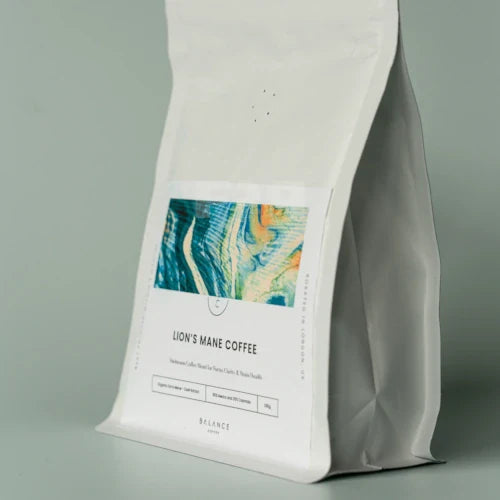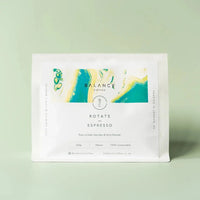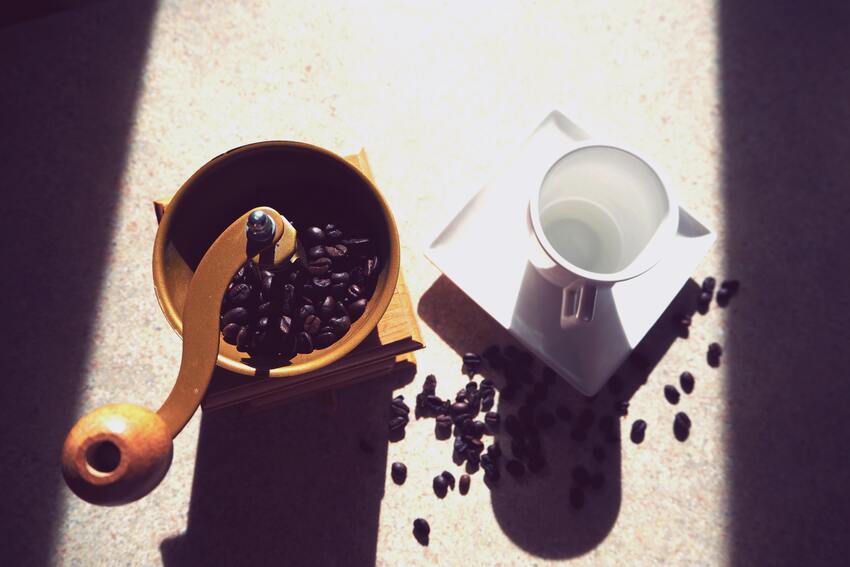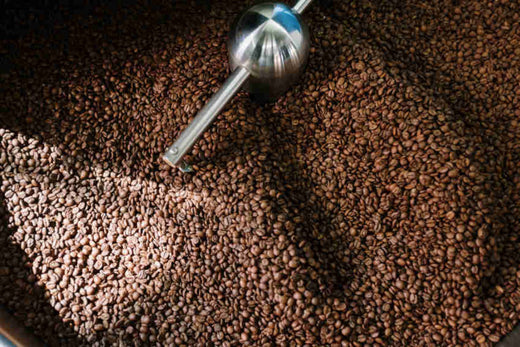How to grind a coffee beans without a grinder, ever asked this question?
Look no further as I have got the perfect solution for you.
Today, we explain how to grind coffee beans at home for maximum flavour.
You can have the ultimate caffeine experience with freshly ground beans.
The best thing? These are of the highest quality, and you will feel satisfied after a cup.
Why Grind Coffee Beans when Pre-Ground Coffee is Available?
Pre-ground coffee beans from the supermarkets do not give you the same flavour and taste as fresh ground...
The reason is simple: fresh grounds from a Barista are fresh, and supermarkets aren't.
Coffee beans retain freshness better than pre-ground coffee.
That's because the whole bean locks in the gases and flavours. As a result, coffee beans typically last 5-10 weeks after roasting.
However, when you compare this to pre-ground coffee, it begins to get stale immediately after they are roasted and ground.
Why? When exposed to oxygen, oxidation occurs.
This means that the air begins to affect the oils in the beans, causing it to evaporate.
Also, this leads to a decline in taste and smell by the time it reaches you.
Some key factors that affect the freshness of pre-ground coffee beans are:
→Oxidation: When pre-ground coffee comes into contact with air, it enables the process of oxidation.
This changes the taste and flavour of the coffee beans. The ground coffee you get from the supermarket has already been oxidised. Hence, it can have a milder, more subdued taste than when you freshly grind coffee beans.
→Moisture: The oil present in the coffee beans is highly soluble in water.
It is the primary ingredient that gives you coffee's rich, authentic taste and smell.
When the pre-ground coffee comes in contact with moisture in the air, the oil starts dissolving.
This takes away the richness of the coffee ground with it.
→Grind size: The size of the granules or particles of your coffee determines how intense your coffee will taste in the end. For example, if your coffee tastes watery and acidic, the beans are grounded too coarsely. Conversely, you can find your coffee too bitter if you use finely ground coffee beans. 
How can the size of ground coffee beans affect your coffee taste?
We grind coffee beans to increase the surface area of coffee that comes in contact with water.
A coarser grind will allow water to pass through it easier than a finer grind. As a result, it affects the brew time and extraction efficiency.
A more robust coffee will require finer grounds, while a weaker one can do with a coarser consistency.
This is due to bean density which comes from the origin of the coffee itself. The altitude and the roast level of the bean are also one of many factors.
Coffee ground sizes are used in different brewing methods. The appropriate grind size for each type of coffee is as follows:
| Grind Size | Brewing Method |
|---|---|
| Extra Coarse | Cold Brew |
| Coarse | French Press, Percolator, Vacuum Coffee Pot |
| Medium | Filter Coffee, Drip Coffee Makers, Aeropress, V60 |
| Medium-Fine | Moka Pot / Stovetop |
| Fine | Espresso Machines |
| Super Fine | Turkish Coffee |
Grinding fresh coffee beans at home will give you control over the coarseness you want.
and the right texture and flavour that you crave in your brew.
Ways You Can Grind Coffee Beans at Home
Perfectly grinding coffee beans at home will give you the cup of good-tasting coffee you desire every morning.
Everyone wants to start their day on the right note, so the next thing you need to consider is how to grind the coffee beans.
First, you'll need to decide whether to invest in a coffee grinder or try grinding coffee beans without one manually.
You might want to jump right into the grinding process and forget about exploring alternative ways to grind coffee.
Alternatively, If the thought of grinding coffee beans without a grinder overwhelms you, fear not.
Here are some ways to create perfectly ground coffee beans without owning a grinder.
Ways to Grind Coffee Without a Grinder.
If, like most of us, you already have a blender or a food processor at home, grinding coffee without a grinder would be achievable! However, we are purveyors of quality coffee here at Balance, and we will say this.
Grinding your coffee beans with a high-quality grinder will deliver the best flavour in the cup.
These are how to get the perfect ground coffee beans without a grinder.
1. Use a Blender to Grind Coffee Beans:
With a blender, you can grind your coffee beans in no time.
The blender's blade will grind the coffee beans much like an electric coffee grinder, though you cannot control the beans' coarseness as you can with an electric coffee grinder.
Some blenders have a grind setting, but if not, you can use the pulse setting or manually blend the coffee beans yourself.
Ensure you do not overheat the blender by adding too many coffee beans at once, as it might damage your blender and result in uneven chunks of coffee beans.
Grind your coffee beans in short, quick bursts with an on-and-off grinding technique to achieve the perfect ground texture.
How to Grind Coffee Beans with a Blender
- If your blender has a 'grind' setting, select it. Otherwise, blend the coffee beans on medium-high.
- Do not overload the blender with coffee beans. Put about ¼ cups to ½ cups of coffee beans in the blender and close the lid firmly.
- Set the blender on the pulse setting and blend in short, sharp bursts. Blending for a longer duration can overheat the blender and damage it. Overheated blenders can also burn the coffee beans, leading to bitter-tasting coffee grounds.
- Check in between to see if the coffee beans have reached the desired coarseness, and voila, your coffee beans are ready to be savoured!
Pro Tip:
Remember to shake and stir the grounded coffee beans between blending to ensure they blend evenly. Also, keep the lid firmly shut while blending to prevent the coffee beans from flying off and causing a kitchen mishap.
Use a Food-Processor to Grind Coffee Beans:
Do you know you can also grind your coffee beans espresso-style by using a food processor? You can use your food processor much the same way as your blender. Make sure to put a bit more coffee beans in it as it has a wider circumference than a blender and would require more to blend correctly.
How to Grind Coffee Beans in a Food Processor
- Pour 1 to 1.5 cups of coffee beans into your food processor and firmly shut the lid. You have to pour a little more than while using the blender as the food processor is wider and would require more beans to get that perfect ground texture.
- Use your processor's 'Pulse' setting in a short burst to get the perfect grind. Remember to shake the processor in between to ensure a uniform texture of the coffee grind.
- Depending on how long you run the processor, you can get a coarse grind or a medium-fine grind.
Pro-Tip:
To ensure the right consistency, keep adding a few beans at a time while using the food processor. This will allow you to control the grind size and texture of the ground coffee beans while grinding.
You Can Grind Coffee Beans Manually
If you prefer to grind coffee without an electric grinder, try grinding coffee beans manually!
The process might be a tad longer and slower, and you will need more patience and a dollop of elbow grease, but the result may be more therapeutic for you. One other benefit is the saving of electricity. 
Here are some of the ways you can grind coffee beans manually:
→Use the rolling pin:
This is the easiest way to grind coffee beans if you rush to get your morning caffeine fix.
If you have time, take a small number of coffee beans (preferably weigh these out) and put them in a Ziplock bag.
Put the bag with the beans flat on the counter. Roll the coffee over it with your rolling pin.
Start at the base and slowly roll over the beans to achieve the ground texture you need for your given brew method.
Pro-tip:
Make sure the bag does not have any residue air, as that would pop the bag open when you roll over its contents!
→Use a large knife:
You can grind your coffee beans using a large, flat butcher's knife and a chopping board.
Use a large chopping board to ensure no over-spill of coffee beans.
Place some beans on the chopping board and press the knife down slowly to achieve the desired texture.
→Use Mortar and Pestle:
If you have more time and patience, using a mortar and pestle can give you more evenly ground coffee powder.
The benefit here is that the more even the grind size, the better the extraction. A good extraction equals a good-tasting coffee drink.
How to use mortar and pestle to grind coffee beans
- Fill about half of your mortar with the coffee beans of your choice. Ensure that you get a bigger mortar to prevent the beans from spilling over when crushed.
- Hold the pestle with your dominant hand while securing the mortar with your other hand.
- Crush the coffee beans using the pestle as a hammer and occasionally stirring them to mash them consistently.
- Calmly grind the beans until you get the consistency you prefer.
→Use a Hammer: You can use a hammer to crush the coffee beans to a consistency you like. Like the rolling pin method, put some coffee beans in a bag and hammer them to your desired consistency.
→Try a Heavy Frying Pan: You can use a large frying pan to crush the coffee beans. Put some coffee beans in a bag and press down the heavy frying pan over it repeatedly to get the right consistency.
→Use a Garlic Crusher: If you are looking for a coarser texture, you can try using a garlic crusher to squeeze the beans to a rougher texture. First, put some beans in the garlic crusher and firmly press until all the coffee beans have passed. Repeat the process till you get a coarse texture.
How to Grind Coffee with a Grinder
It is all well if you have lots of time and patience to grind your coffee beans manually, but the easiest and fastest way to get a batch of perfect ground coffee is to invest in a good-quality coffee grinder.
For one, Niche Zero Coffee Grinder Review is a must-read for any coffee connoisseur. Its compact size makes it ideal for kitchens with limited space.
If you have decided to invest in a coffee grinder that will provide you with the best quality of ground coffee in the comforts of your home, look no further.
Here are the types of coffee grinders you might consider before purchasing one for your home.
How to Choose the Perfect Grinder?
You are spoiled for choice if you are in the market for a coffee grinder to give you perfectly ground coffee beans. But before you get out your wallet, consider which type of grinder will suit your needs:
- Blade or Electric Coffee Grinder
Electric blade coffee grinders, or coffee mills as they are popularly known, are the most common grinders available.
They essentially chop fresh coffee beans using propeller-shaped stainless steel blades that rotate at very high speeds (about 20000-30000 rpm).
The longer you run it, the finer the texture of the coffee beans. It does not have separate settings for different types of grinds.
You have to determine the coarseness by the length of time you run the machine. Whilst this solution works well, you don't have complete control because it's based on speed rather than grind size.
Benefits:
→ Inexpensive: The main advantage of this grinder is that it is inexpensive, ranging from £30 to £100 in price. That is quite appealing as good burr grinders typically cost between £100 to £300 for home use, excluding the premium range, of course.
→ Small Size: This grinder would be your ideal solution if you have a smaller kitchen and generally lack space in your home. It is also portable and can be taken with you when travelling.
Drawbacks:
→ Lack of uniform particles: The grinder chops the fresh coffee beans rather than grinds them evenly. It is normal to get ground coffee with a mixture of different-sized coffee beans in it, but that can result in a bitter, unbalanced taste.
⇢ Inconsistent Grinding The grinder's results vary widely from time to time, making it a hit-or-miss situation every time you grind fresh coffee beans.
This will impact the consistency of the coffee you drink daily. If you're picky and you like consistently tasty coffee, then a higher-quality solution will be in order.
⇢ Grinder Heats Up Fast: As the grinder uses fast-rotating blades to grind coffee beans, using it for a long time will overheat the machine. This may burn the coffee beans, giving them a bitter, burnt taste.
Pro-Tip:
Let's face it; not everybody wants to invest in an expensive, state-of-the-art coffee grinder to grind coffee beans at home.
If you have budget and space constraints but still want to grind coffee beans occasionally at home, here are some tips.
⇢ Use a short burst to grind your coffee to prevent the beans from getting burnt. It would also prevent the overheating of your grinder, prolonging its life.
⇢ Grind a small number of fresh coffee beans right before brewing your coffee. That way, you can get a flavourful brew every time you crave a caffeine fix.
⇢ Adjust your grind time to get the texture you want. For instance, grind the coffee beans for 8-10 seconds for a coarser grind. Increase the time to 12-15 seconds for a more refined texture. Practice often to find the exact time the grinder takes to provide the right texture for your brew.
2. Burr Coffee Grinder:
Unlike a blade coffee grinder, a burr coffee grinder uses two fast-spinning discs to precisely crush coffee beans.
As burr grinders are designed to achieve a more uniform grind, this is due to the shape of the burrs themselves, the power, and the chamber.
Rather than chopping the coffee beans into uneven pieces, a burr grinder will provide more uniform particles than the blade counterparts.
Because of this, a burr grinder would significantly improve the quality of your brew in the cup.
There are two types of burrs you can choose from: flat and conical. How are they different, and which one should you buy? Read on to decide that for yourself.
⇢Flat Disc Burr Coffee Grinder A burr coffee grinder uses pressure between two discs to grind coffee beans. Flat burrs have two rings that lie flat on top of each other. They are horizontally aligned and have angular teeth. The distance between the teeth determines the size of the grind, which is what adjusts when you adjust the grind setting.
⇢Conical Disc Burr Coffee Grinder
You can often find these grinders in coffee shops. Here, the conical burrs sit vertically, one inside the other. This means the grinding itself also takes place vertically. The outer burr is a hollow ring with angular teeth. The inner burr is conical with a large base. It looks flower-shaped from above.
Flat vs. Conical Burr Coffee Grinders
Your brew quality can be affected by the grind consistency, temperature, and retention, which again can be influenced by the shape of the burr in the grinding machine.
While there has been an ongoing debate on the pros and cons of both types of burrs, without going into the technicalities, it has been proved that both types of coffee grinders are likely to produce uniformly ground coffee despite having structural differences.
Irrespective of what shaped burr grinders you purchase, if you have a good-quality burr grinder, the shape of the burrs will not make that much of a difference in your brew quality.
You can focus on other things, like water quality. Despite the disclaimer, coffee connoisseurs have their own preferences for which shape produces the best coffee grounds.
The following theories are considered while deciding between the two types of burr grinders
⇢ Retention - Flat burrs retain more ground than conical burrs. While grinding your fresh coffee beans, you need to consider how many excess grounds are left in the burr, which will then be dosed into the next coffee shot. The problem with this is that you can dose old coffee packed inside the coffee grinder from the last shot.
⇢ Ease of Use - Baristas agree that conical burrs are easy to dial in and require minimal adjustments.
⇢ Different Burrs for Different Tastes - Some coffee experts have claimed that conical burrs bring out brighter and more individual flavours. In contrast, flat burrs specialise in enhancing dark notes and chocolatey flavours.
⇢ Noise Issues - Generally, flat burrs are noisy and can heat up quickly, while conical burrs are quieter and cooler to use.
⇢ Cost - Flat burrs are more expensive and consistent, while conical burrs can be cheaper but less consistent in quality.
If you want to invest in a grinder that produces perfectly ground coffee with a consistent grind every time, this is a machine you should consider.
Wilfa Svart Coffee Grinder-Aroma Precision
This electric coffee grinder is an affordable way to make the perfect ground coffee at home or office. It suits a variety of brew methods, including AeroPress, Filter, and French Press, and always provides a consistent grind for a tasty brew. Additional Info:
- Adjustable grind size for steeped brewing through to espresso coffee extraction
- Intelligent grind basket to minimise mess
- Adjustable grind time for "set and forget" coffee grinding
- EU Two Pin plug (adaptor provided)
- SKU: CGWS-130B
Hand Coffee Grinders
If you want to grind fresh coffee beans even when the power is out, hand coffee grinders are the answer.
If you have some time to spare and do not mind the elbow grease, a hand coffee grinder can provide you with decent, consistent ground coffee.
Should manual grinders be your preference, look no further.
Hario Coffee Grinder - The Prism
The Hario Prism is a beautiful manual coffee grinder with a ceramic burr and aluminium body.
Equally important is the compact, elegant design, perfect at home or on the go.
If you want to grind your coffee beans daily, the Hario Prism coffee grinder is durable and will do just that. Some of the features of the grinder are:
- Ceramic Burrs
- Plastic Inner Hopper
- Aluminium Outer Hopper
- Handheld & Travel Friendly
Hario Prism Coffee Grinder Dimensions:
- W145 x D52 x H200mm
Shop Hario Prism Grinder.
Common Mistakes to Avoid While Grinding Coffee Beans at Home
If grinding coffee beans at home does not yield the quality of brew you desire, you must be doing something wrong. Read on to discover the most common mistakes and what you can do differently to get the perfect ground coffee your taste buds desire.
The Perfect Grind for Your Gadget
Several grind variations are suitable for different coffee methods.
The secret to making that perfect brew is matching the grind to the style of coffee you are preparing.
If you do not know which grind goes with which coffee style, your brew will not be satisfactory. Here is a breakdown of each grind and the gadgets used in it.
A Coarse Grind (salt-like texture) is used in ⇢French Press, ⇢Cold Brew, ⇢Vacuum Coffee maker, ⇢Percolator.
Medium Grind (texture of brown or white sand) is used in ⇢Auto Drip Makers ⇢Drip-Makers with cone-shaped filters ⇢Manual Filter Coffee Maker, such as (Aeropress, V60 Brewer)
A Fine Grind (the texture of regular table salt or sugar) is used in Stovetop or espresso moka pots and Espresso Machines.
A Turkish Grind (Texture of baby powder)is used in ⇢Turkish Style Coffee
Using Coffee Beans of a Poor Quality
You need to invest in high-quality coffee beans to have an excellent-quality grind.
Over-roasted coffee beans have an intensely bitter flavour that will ruin the taste of your coffee even when you grind the coffee freshly at home.
To make the perfect brew, your beans must be fresh, and you must use the proper roast style and quality raw ingredients.
If you are unsure about the quality of the coffee beans, consider investing in the Balance Coffee Bean Subscription.
Our coffee subscription fits perfectly into your busy lifestyle.
You can taste exciting new coffee flavours from around the world, delivered right to your doorstep. Click here to learn more.
Grinding your Coffee Too Early
Coffee beans' flavour comes from the oils within them. To get the best flavours from coffee beans, grind them as close to brewing time as possible.
Grinding the coffee beans well ahead of time can cause them to lose their oil, resulting in a stale taste in your brew.
For best results, make sure the brewing water is ready as you grind the coffee beans, and use them immediately after grinding to preserve freshness throughout the beans and the water.
Failing to Use The Correct Weight of Coffee Beans
Always measure the fresh coffee beans you use while grinding, as using too much will waste them. Remember your daily consumption and grind the appropriate amount of coffee beans to prevent waste.
Using a Dirty Coffee Grinder
Fresh coffee beans tend to absorb the odours of other food. Using the grinder to prepare other food and failing to clean it before grinding your coffee beans may result in your coffee being contaminated with the flavour of the other food.
To make the best ground coffee, clean the grinder before use. Before grinding the coffee beans, grind some hard, uncooked white rice to remove the stale smell and any residue left in the machine. Another option is to purchase some cleaning tablets.
Interesting facts about coffee to ponder on:
1) Caffeine Content Changes Based on Roast of Coffee
The beans lose about 90% of their water content during roasting. If you measure your coffee by scoops, the lightly roasted coffee will have more caffeine. Since the beans are denser than the darker roast. However, if you weigh out your scoops, the darker roasts will have more caffeine because they have less mass.
2) Storage of Coffee Beans
The best way to store coffee beans is in sealed containers made from glass or ceramic. Glass containers, if used, must be kept in dark places away from direct sunlight. In any case, you must always store fresh coffee beans in an airtight, moisture-proof container. Make sure you avoid putting coffee in the fridge, as it can absorb more moisture.
3) How long can you store coffee beans?
Coffee beans can be stored in an air-tight container for up to 3 months. However, they'll lose some freshness, so we recommend drinking within 2-6 weeks from the roast date. Anything after this will taste stale due to the loss of aromatic and volatile compounds.
5) What are espresso beans?
In theory, an espresso roast is coffee specifically designed to be used when making espresso. It would generally work with milk-based drinks but wouldn't be suitable for filter coffee, as it would have been roasted longer. The name 'espresso roast' denotes different blends of coffee used to achieve an optimal espresso.
6) What is dirty coffee?
Dirty coffee is made with cold milk and a double shot of espresso. Its name comes from the brew's rich, dark brown colour.
7) What is a mocha - latte?
A latte is an espresso-based milky drink. A mocha latte is a latte with a dash of chocolate syrup.
8) Can you grind coffee beans in the Ninja Blender?
Although coffee grinders are more suitable, you can still grind coffee beans in the Ninja blender. Look for a Ninja with at least 500 watts of power to grind the coffee beans effectively. Also, use a small amount to have a consistent grind and blend on a low or pulse setting.
9) Can you grind coffee beans in Nutribullet?
The Nutribullet can grind your coffee beans more precisely than a blender or food processor. Use the pulse setting and grind quickly to get the desired texture.
10) What is the difference between instant coffee and ground coffee?
Ground coffee is made from roasted coffee beans, which are then ground in a coffee grinder. Instant coffee is a soluble form of freeze-dried coffee, which we suggest avoiding at all costs.
11) Can you use ground coffee to make Dalgona?
Dalgona coffee is made with instant coffee, water, milk, and sugar. However, you can also use ground coffee or whipped coffee.
Just add a bit more sugar to turn it into a nice, fluffy texture. Check out our Dalgona recipe guide here.
12) Can you freeze ground coffee?
Most people are unaware that ground coffee can be successfully frozen. However, precision and speed are required to make it work before moisture deteriorates and impacts coffee quality.
Frozen beans are said to increase grind uniformity due to the harder, more robust coffee beans because they are frozen.
Conclusion:
In the end, it all boils down to preference and taste.
Following the tips and tricks from the team at Balance Coffee, you can grind coffee beans at home to upgrade your coffee game and enjoy top-quality coffee just like your barista made it.
Get started right away and enjoy your barista-style brew right in the comforts of your home.















